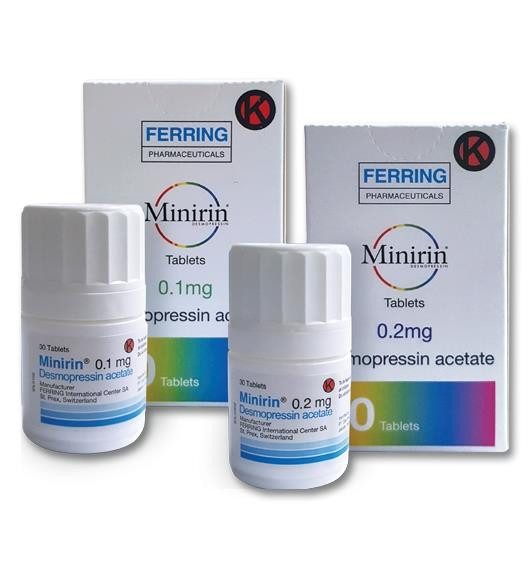Definisi
Diabetes insipidus atau Diabetes air adalah jenis Diabetes yang ditandai dengan peningkatan rasa haus dan frekuensi buang air kecil (BAK). Diabetes insipidus tidak berhubungan dengan Diabetes melitus yang memiliki beberapa tanda dan gejala yang sama.
Jika Anda ingin mengetahui lebih lanjut mengenai Diabetes Melitus, Anda dapat membacanya di sini: Diabetes Melitus – Pengertian, Penyebab, Gejala, dan Pengobatan.
Pada kasus Diabetes insipidus yang sangat parah, seseorang dapat buang air kecil hingga 20 liter dalam sehari. Diabetes insipidus dapat bersifat kronis (seumur hidup) atau sementara dan ringan atau berat tergantung penyebabnya.
Di Amerika Serikat, prevalensi Diabetes insipidus sebanyak 3 per 100.000 populasi. Sedangkan Diabetes insipidus gestasional sebanyak 4 per 100.000 kehamilan.
Penyebab
Diabetes insipidus disebabkan oleh gangguan pada hormon anti-diuretik (ADH) atau juga disebut vasopresin. ADH memainkan peran kunci dalam mengatur jumlah cairan dalam tubuh. Hormon ini diproduksi di bagian otak yang disebut hipotalamus.
ADH berpindah dari hipotalamus ke kelenjar hipofisis untuk disimpan sampai dibutuhkan oleh tubuh. Kelenjar hipofisis melepaskan ADH ketika jumlah air dalam tubuh terlalu rendah. Fungsinya, membantu menahan air dalam tubuh dengan mengurangi jumlah air yang hilang melalui ginjal, membuat ginjal menghasilkan urin yang lebih pekat.
Pada Diabetes insipidus, kurangnya produksi ADH berarti ginjal tidak dapat membuat urin yang cukup pekat dan terlalu banyak air yang keluar dari tubuh.
Jenis-Jenis Diabetes Insipidus
Berdasarkan penyebabnya, Diabetes insipidus dibagi menjadi beberapa tipe, yaitu:
- Diabetes insipidus sentral
Kerusakan pada kelenjar hipofisis atau hipotalamus akibat pembedahan, tumor, cedera kepala, atau penyakit dapat menyebabkan Diabetes insipidus sentral dengan memengaruhi produksi, penyimpanan, dan pelepasan ADH.
- Diabetes insipidus nefrogenik
Terjadi ketika adanya kerusakan pada struktur di ginjal yang membuat ginjal tidak dapat merespons ADH dengan baik. Hal ini mungkin disebabkan oleh kelainan bawaan (genetik) atau kelainan ginjal kronis.
- Diabetes insipidus gestasional
Pada ibu hamil, enzim yang dihasilkan oleh ari-ari menghancurkan ADH. Diabetes insipidus gestasional jarang terjadi.
- Polidipsia primer
Dikenal juga sebagai Diabetes insipidus dipsogenik. Polidipsia primer disebabkan oleh kerusakan mekanisme pengatur rasa haus di hipotalamus. Kondisi ini juga dikaitkan dengan penyakit mental, seperti skizofrenia.
Faktor Risiko
Beberapa faktor risiko Diabetes insipidus:
- Ada keluarga yang menderita Diabetes insipidus.
- Pernah mengalami operasi pada otak atau cedera kepala berat.
- Minum obat yang dapat menyebabkan masalah ginjal.
- Memiliki gangguan metabolisme tertentu, seperti kadar kalsium darah tinggi atau kadar kalium darah rendah.
- Pada ibu hamil, berisiko lebih tinggi mengalami Diabetes insipidus gestasional jika hamil kembar, memiliki kondisi yang memengaruhi fungsi hati, seperti preeklamsia dan/atau sindrom HELLP.
Baca lebih lanjut mengenai preeklamsia di sini: Preeklamsia – Pengertian, Penyebab, Gejala, dan Pengobatan
Selain faktor risiko di atas, pada Diabetes insipidus nefrogenik yang muncul segera setelah lahir biasanya memiliki penyebab bawaan (genetik) yang secara permanen mengubah kemampuan ginjal untuk memekatkan urin. Diabetes insipidus nefrogenik biasanya menyerang laki-laki, meskipun perempuan dapat menurunkan gen tersebut kepada anak-anak mereka.
Gejala
Diabetes insipidus memiliki beberapa tanda dan gejala seperti Diabetes melitus, yaitu:
- Rasa haus sepanjang hari
- Peningkatan frekuensi buang air kecil
- Peningkatan jumlah urin
- Warna urin bening atau tidak pekat
- Berkemih saat malam hari (nokturia)
- Kelelahan, dikarenakan kualitas tidur yang terganggu akibat sering terbangun untuk berkemih di malam hari
Diagnosis
Diagnosis Diabetes insipidus adalah diagnosis yang dapat ditegakkan melalui wawancara medis, pemeriksaan fisik, hingga pemeriksaan penunjang bila tersedia dan diperlukan untuk dilakukan.
Pada wawancara medis, dokter akan menanyakan gejala yang dirasakan oleh pasien saat ini, seperti rasa haus berlebih, berapa kali BAK dalam sehari, hingga ada/tidak di keluarga yang mempunyai penyakit diabetes insipidus. Setelah wawancara medis, pemeriksaan selanjutnya adalah pemeriksaan fisik. Pada tahap ini dilakukan pengukuran tanda-tanda vital, yaitu tekanan darah, frekuensi pernapasan, frekuensi denyut nadi dan suhu tubuh.
Bila diperlukan pemeriksaan lebih lanjut, maka dokter akan melakukan pemeriksaan penunjang, meliputi:
- Tes kekurangan air
Tes ini dilakukan dengan pengawasan dokter atau tim perawatan kesehatan. Anda akan diminta berhenti minum cairan selama beberapa jam. Untuk mencegah dehidrasi saat cairan dibatasi, ADH memungkinkan ginjal Anda mengurangi jumlah cairan yang hilang dalam urin. Saat cairan ditahan, dokter Anda akan mengukur perubahan berat badan, keluaran urin, dan konsentrasi urin dan darah Anda.
- Uji Vasopresin
Pada saat melakukan tes kekurangan air, dokter akan menyuntikkan ADH sintesis untuk mengukur kadar ADH dalam darah. Ini akan menentukan apakah tubuh Anda memproduksi cukup ADH dan apakah ginjal Anda dapat merespons ADH seperti yang diharapkan.
- Tes infus garam hipertonik
Campuran air dan garam diberikan secara intravena dan kemudian darah pasien diuji untuk konsentrasi partikel dan kadar vasopresin.
- Skrining genetik
Jika orang lain dalam keluarga Anda memiliki masalah dengan buang air kecil berlebih, Anda disarankan untuk melakukan pemeriksaan genetik.
Pemeriksaan Radiologi
- Pencitraan resonansi magnetik (MRI)
MRI dapat mencari kelainan di dalam atau di dekat kelenjar hipofisis. Tes ini tidak invasif karena menggunakan medan magnet yang kuat dan gelombang radio untuk membuat gambar jaringan otak yang terperinci.
Tata Laksana
Pengobatan dan terapi pada Diabetes insipidus berbeda tergantung jenisnya:
- Diabetes insipidus sentral
Dapat diterapi dengan hormon sintetik yang disebut desmopresin. Obat ini menggantikan ADH yang hilang dan mengurangi frekuensi buang air kecil. Anda dapat mengonsumsi desmopresin dalam berbagai jenis sediaan, seperti bentuk tablet, sebagai semprotan hidung (inhaler) atau dengan suntikan.
- Diabetes insipidus nefrogenik
Diet rendah garam untuk mengurangi jumlah urin yang dihasilkan ginjal, minum air yang cukup untuk menghindari dehidrasi. Pengobatan dengan obat hydrochlorothiazide juga dapat mengurangi gejala yang Anda alami.
- Diabetes insipidus gestasional
Pengobatan untuk Diabetes insipidus gestasional adalah dengan pemberian hormon sintetik desmopresin.
- Polidipsia primer
Tidak ada pengobatan khusus untuk bentuk Diabetes insipidus ini, selain mengurangi asupan cairan. Jika kondisinya terkait dengan penyakit mental, mengobati penyakit mental dapat meredakan gejala Diabetes insipidus.
Komplikasi
Dehidrasi
Komplikasi utama Diabetes insipidus adalah dehidrasi yang terjadi ketika tubuh Anda kehilangan terlalu banyak cairan dan elektrolit. Gejalanya berupa:
- mulut kering
- perubahan elastisitas kulit
- haus
Rehidrasi dengan cairan dapat digunakan untuk mengatasi dehidrasi ringan. Sedangkan pada dehidrasi berat perlu dirawat di rumah sakit.
Ketidakseimbangan Elektrolit
Selain dehidrasi, Diabetes insipidus juga menyebabkan ketidakseimbangan mineral/elektrolit dalam darah Anda, seperti natrium dan kalium, yang menjaga keseimbangan cairan dalam tubuh Anda.
Gejala ketidakseimbangan elektrolit dapat meliputi:
- lelah
- mual
- muntah
- kehilangan selera makan
- kram otot
- kebingungan
Pencegahan
Diabetes insipidus menyebabkan tubuh mudah dehidrasi karena banyak cairan yang dikeluarkan melalui urin. Pencegahan terbaik yang dapat Anda lakukan adalah mengonsumsi cukup cairan agar tidak dehidrasi. Anda dapat membawa air minum kemana pun Anda pergi.
Kapan Harus ke Dokter?
Pada kondisi normal, orang dewasa buang air kecil sebanyak 4-7 kali dalam 24 jam, sedangkan pada anak cenderung lebih sering buang air kecil karena ukuran kandung kemih yang kecil.
Jika Anda merasa haus sepanjang waktu, buang air kecil lebih dari 10 kali dalam sehari atau warna urin bening, hal ini mungkin sebagai tanda bahaya adanya ketidakseimbangan elektrolit pada tubuh Anda, segera periksakan diri ke dokter.
Mau tahu informasi seputar penyakit lainnya? Cek di sini, ya!
- dr Anita Larasati Priyono
Mayo Clinic (2021). Diabetes Insipidus. Available from: https://www.mayoclinic.org/diseases-conditions/Diabetes-insipidus/symptoms-causes/syc-20351269
Medscape (2022). Diabetes Insipidus. Available from: https://emedicine.medscape.com/article/117648-overview#a6
Thadhani RI, Maynard SE (2022). Polyuria and diabetes insipidus during pregnancy. Available from: https://www.uptodate.com/contents/polyuria-and-diabetes-insipidus-of-pregnancy?search=diabetes%20insipidus%20epidemiology§ionRank=1&usage_type=default&anchor=H2078927624&source=machineLearning&selectedTitle=1~150&display_rank=1#H2078927624
Mayo Clinic (2021). Diabetes Insipidus. Availabe from: https://www.mayoclinic.org/diseases-conditions/Diabetes-insipidus/diagnosis-treatment/drc-20351274
Cleveland Clinic (2022). Diabetes Insipidus. Available from: https://my.clevelandclinic.org/health/diseases/16618-Diabetes-insipidus











